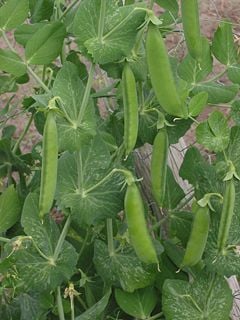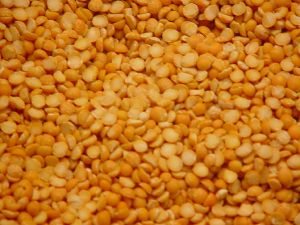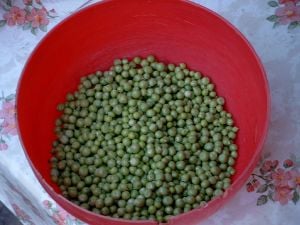Pea
| Pea | ||||||||||||||||||
|---|---|---|---|---|---|---|---|---|---|---|---|---|---|---|---|---|---|---|
 | ||||||||||||||||||
| Scientific classification | ||||||||||||||||||
| ||||||||||||||||||
| Pisum sativum L. |
| Peas (fresh, green) Nutritional value per 100 g | ||||||||||
|---|---|---|---|---|---|---|---|---|---|---|
| Energy 80 kcal 340 kJ | ||||||||||
| ||||||||||
| Percentages are relative to US recommendations for adults. Source: USDA Nutrient database | ||||||||||
| Split peas (raw) Nutritional value per 100 g | ||||||||||||||||
|---|---|---|---|---|---|---|---|---|---|---|---|---|---|---|---|---|
| Energy 340 kcal 1430 kJ | ||||||||||||||||
| ||||||||||||||||
| Percentages are relative to US recommendations for adults. Source: USDA Nutrient database | ||||||||||||||||
A pea is the small, edible round green bean which grows in a pod on the leguminous vine Pisum sativum, or in some cases to the immature pods. This legume is cooked as a vegetable in many cultures. Several other seeds of the family Fabaceae, most of them round, are also called peas; this article deals with the species Pisum sativum and its cultivars. In the South of the United States, "pea" refers to cowpeas, and Pisum sativum is distinguished by calling it green pea or garden pea. The pea plant is an annual plant, with a lifecycle of a year.
History and cultivation
Peas have been found in Near Eastern archaeological sites which date back nearly 10,000 years. Domesticated cultivars appeared relatively shortly after wheat and barley, which appear to have been cultivated as long ago as 7800 B.C.E. By 2000 B.C.E., pea cultivation had spread throughout Europe and east into India and China.
Peas are a cool-season vegetable crop. The seeds may be planted as soon as the soil temperature reaches 10 °C, with the plants growing best at temperatures of 13 °C to 18 °C. They do not thrive in the summer heat of warmer temperate and lowland tropical climates, but do grow well in cooler high altitude tropical areas. Many cultivars reach maturity about 60 days after planting. Peas grow best in slightly acid, well-drained soils.
Peas have both low-growing and vining varieties. The vining varieties grow thin tendrils from leaves that coil around any available support, and can climb to be 1-2 m high. A traditional approach to supporting climbing peas is to thrust branches pruned from trees or other woody plants upright into the soil, providing a lattice for the peas to climb. Branches used in this fashion are called pea brush. Metal fences, twine, or netting supported by a frame, are used for the same purpose. In dense plantings, peas give each other some measure of mutual support.
Crop rotation is important to avoid the build-up of pests and diseases in the soil; typically peas should only be replanted on the same site every fourth year[1].
The average pea weighs between 0.1-0.36 grams [2].
Ways of eating peas
Fresh peas are often eaten boiled and flavored with butter and/or spearmint as a side dish vegetable. Fresh peas are also used in pot pies, salads and casseroles. Pod peas (particularly sweet varieties called mangetout and sugar peas) are used in stir fried dishes. Pea pods do not keep well once picked, and if not used quickly are best preserved by drying, canning or freezing within a few hours of harvest.
Dried peas are often made into a soup or simply eaten on their own. In Japan and other East Asian countries including Thailand, Taiwan and Malaysia, the peas are roasted and salted, and eaten as snacks. In the UK, marrowfat peas are used to make pease pudding (or "pease porridge"), a traditional dish. In North America a similarly traditional dish is split pea soup.
In Chinese cuisine, pea sprouts (豆苗 dou miao) are commonly used in stir-fries.
In the United Kingdom, dried, rehydrated and mashed marrowfat peas, known by the public as mushy peas, are popular, originally in the north of England but now ubiquitously, and especially as an accompaniment to fish and chips or meat pies, particular in chippies or fish and chip shops. Sodium bicarbonate is sometimes added to soften the peas. In 2005, a poll of 2,000 people revealed the pea to be Britain's 7th favourite culinary vegetable.
Processed peas are mature peas which have been dried, soaked and then heat treated (processed) to prevent spoilage - in the same manner as pasteurising.
Cooked peas are sometimes sold dried and coated with wasabi as a spicy snack.
Some forms of etiquette requires that peas be only eaten with a fork and not pushed onto the fork with a knife [3][4].
Peas in science
Pioneering geneticist Gregor Mendel studied seven traits of pea pods in teasing out three early laws of genetics.
Etymology
According to etymologists, the term was taken from Latin and adopted into English as the singular term "pease", as in pease pudding below. However, by analogy with other plurals ending in "-s", speakers began construing "pease" as a plural and constructing the singular form by dropping the "s", giving the term "pea". This process is known in linguistics as back-formation.
- Pease pudding hot,
- Pease pudding cold,
- Pease pudding in the pot,
- Nine days old
- Some like it hot,
- Some like it cold,
- Some like it in the pot
- Nine days old
The name marrowfat pea for mature dried peas is recorded by the OED as early as 1733. The fact that an export variety popular in Japan is called Maro has led some people to assume mistakenly that the English name marrowfat is derived from Japanese.
External links
Template:Cookbookpar
Credits
New World Encyclopedia writers and editors rewrote and completed the Wikipedia article in accordance with New World Encyclopedia standards. This article abides by terms of the Creative Commons CC-by-sa 3.0 License (CC-by-sa), which may be used and disseminated with proper attribution. Credit is due under the terms of this license that can reference both the New World Encyclopedia contributors and the selfless volunteer contributors of the Wikimedia Foundation. To cite this article click here for a list of acceptable citing formats.The history of earlier contributions by wikipedians is accessible to researchers here:
The history of this article since it was imported to New World Encyclopedia:
Note: Some restrictions may apply to use of individual images which are separately licensed.


